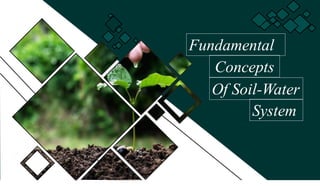
Soil-Water System_organized.pdf
- 2. CONTENTS Absorption of water Plant water status Water movement in Soil ✓Entry of water ✓Soil pores ✓Soil water ✓Field capacity ✓Permanent wilting Fundamental concepts 01 02 03 04 ✓Soil texture & Structure ✓Gravityaction ✓Capillaryaction ✓Sandy & clayey soil ✓Active transport ✓Passive transport ✓Plant water status ✓Plant water potential
- 3. Fundamental concepts of Soil-Water System ✧ Entry of water into Soil Water enters into soil by process of Infiltration and further movement of water in soil occurs by process of Percolation ✧ Infiltration In this process water is absorbed in the soil mass (upper layer of the earth crust) to meet the soil moisture deficiency. Infiltration Precipitation evapo-transpiration
- 4. Fundamental concepts of Soil-Water System ✓ After meeting the soil moisture deficiency if any excess water is available, it will move vertically downward and meet the G.W.T.(ground water table), this vertical downward movement is called as percolation. Percolation Percolation Precipitation Infiltration Soil water seepage evapo-transpiration To deep ground water To stream stream
- 5. Soil Pores Two types of pores in soil. ✧Macropores Large soil pores, water does not retain in them due to their larges sizes, air particles entrapped in them. ✧Micropores Small soil pores, hold water against the force of gravity. Only water entrapped there is used by the plants by capillary action. Macropores Micropores
- 6. Carbon Cycle Types of water ✧Gravitational water Form of water, which reaches at the soil water table due to the gravitational force after the rainfall. This form is not available to plants. ✧Hygroscopic water Thin film of water is tightly held by the soil particles is called hygroscopic water. This water is also not available to the plants. ✧Capillary water Water exists between soil particles in small capillary pores is called Capillary water. It is the most common available form of water for absorption. Gravitational Hygroscopic Capillary
- 7. Field capacity & permanent wilting ✧ Field capacity: “Field capacity is the amount of soil moisture or water content held in the soil after excess water has drained away” At field capacity the soil is wet and contains all the water it can hold against gravity. ✧ Permanent wilting point: At the “Permanent Wilting Point” (PWP) the soil is dry and the plant can no longer extract any more water from soil. Wilting point Field capacity Unavailable water Available water
- 8. Water movement in soil ✧ Water movement in the soil is strongly influenced by soil texture and soil structure. ✧ Water moves more quickly through the large open macropores found on sandy soils than the smaller pores of silt or much smaller micropores in dense clay soils. ✧ Gravity is the dominant force that moves water downward while capillary action is the major force for movement of water in any direction i.e., upward, and lateral water movement. ✧ Water movement in sandy soil is mostly through gravitational water movement because of their large pore spaces. ✧ Clayey soils on the other hand have many micropores, hold more water than sand.
- 9. ✓ “Plant water status reflects the plants response to soil-water supply and atmospheric demand driven by water.” ✓ Water potential determines the direction of the flow of water in any system. i.e. water moves from high water potential to low water potential. ✓ The water potential helps to understand how the movement of water takes place into the root and within the plants. Plant water potential Plant water status
- 10. In higher plants water is absorbed through root hairs which are in contact with soil water. Two mechanisms of water absorption in plants: Absorption of water in plant systems (1) Active Absorption (2) Passive Absorption Osmotic Absorption Non osmotic Absorption
- 11. ✓ Root cells play active role in the absorption of water and metabolic energy released through respiration is consumed. Active absorption may be of two kinds: ✓ When water is absorbed from the soil into the xylem of the roots according to the osmotic gradient. ✓ When water is absorbed against the osmotic gradient. Active Absorption of water Osmotic absorption of water Non osmotic absorption
- 12. ✓ It is mainly due to transpiration, the root cells do not play active role and remain passive. ✓ During absorption of water by roots, the flow of water from epidermis to endodermis may take place through three different pathways: (i) Apoplastic pathway (cell walls and intercellular spaces), (ii) Trans-membrane pathway (by crossing the plasma membranes) and (iii) Symplast pathway (through plasmodesmata). Passive absorption of water Apoplast pathway Symplast pathway Vacuole Cytoplasm Cell wall Plasmodesmata
- 13. Thanks❥ ♡